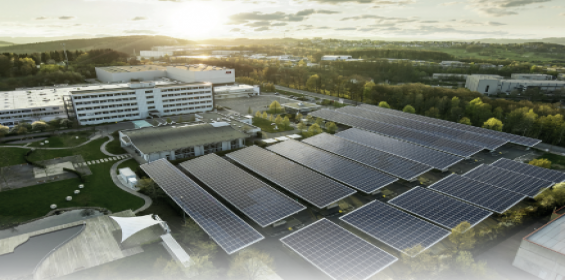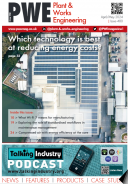Thinking workplaces and homes can help us create a safer more sustainable world
Published: 23 November, 2022
Adapting our buildings following the Covid pandemic is an invaluable opportunity to reimagine the relationship between buildings and the health of their occupants, writes Dr Thorsten Müller, Head of Global Product Group Building and Home Automation Solutions at ABB.
Covid-19 has changed beyond recognition the ways in which people work, live and connect with each other. In the space of just two years, homeworking has become the ‘new normal’ for many, blurring the boundaries between workspace and the home environment, and replacing or supplementing face-to-face interaction with virtual technologies and remote working.
The pandemic and its associated restrictions have accelerated the need for industry leaders, real estate owners, developers and employers to think quickly about how business operations will change and buildings will need to perform differently. Digital technologies, such as artificial intelligence (AI), the Internet of Things (IoT) and data analytics, will play a leading role in delivering strategic business plans and the workplaces of the future.
The rise of the ‘thinking building’
In offices and factories around the world, business owners are reassessing the floor space and the quality of the offices they need in order to adapt to evolving working practices and new expectations of building performance. Integrating technology solutions for greater connectivity will be key in responding to this gear change.
As occupancy levels potentially drop and floor space requirements change there’s an opportunity to optimise and reduce costs. Of course, you need to be able to measure something in order to improve it, and this is where role of data analytics is becoming increasingly important. Building owners looking to future-proof the marketability of their facilities are creating smart, sustainable buildings that use interconnected technologies to improve energy efficiency by as much as 30 percent across key facilities such as heating, lighting and ventilation, as well as enhancing the safety and comfort of occupants.
The data captured by digital energy and asset management systems in these smart buildings is also of enormous value in the postpandemic workplace, enabling businesses to make more informed health-related decisions. For example, IoT sensors can track indoor air quality, numbers of occupants and how they use space and resources, helping to create a ‘contactless’ environment with safe, personalized spaces for employees and visitors. The number of IoT smart buildings’ active connections in the EU alone is expected to exceed 154 million by 2025.
What’s even more innovative and inspiring is that systems combining technologies such as AI, machine learning, Cloud-enabled IoT and automation constantly evolve and optimise themselves over time. These ‘thinking buildings’ allow business and building owners to consistently refine energy and space management, while responding and adapting to the habits, comfort, and experience of occupants.
So, digitalisation and automation can reduce the carbon footprint and running costs of buildings, as well as optimise productivity. However, with Covid having taken a physical, mental or emotional toll on so many, I believe that adapting workplaces to meet the new needs of employees is an invaluable opportunity to reimagine the relationship between buildings and the health of their occupants.
By this I mean that there is a direct correlation between how people feel and how they function, and ‘thinking buildings’ – as we’ve defined them – can play an important role in creating safe, sustainable spaces that have the potential to improve the well-being and productivity of employees and visitors.
Innovative collaborations to create smart homes
Of course, this is not just limited to commercial real estate. Half of all buildings are residential, and many people continue to work from home. Approximately, one-third of all energy consumption goes on powering, heating and cooling buildings and replacing housing stock with more efficient, environmentally friendly homes will potentially take many decades.
A new partnership between our technology and Samsung is now allowing smart technology to make existing homes work more efficiently and drive energy savings. By integrating heating, ventilation and airconditioning (HVAC) products and the variable refrigerant control (VRF) room control systems, occupants can now control all appliances and systems – from white goods and door entry – from their digital devices.
The project will be the first to offer home automation at this scale, helping home and building owners to manage energy peaks; for example, knowing when devices such as dishwashers are turned on or off so they don’t all operate at once and avoid strain on the grid. Connecting the building as a whole also empowers owners to take a holistic approach to energy consumption and connect to broader solutions like electric vehicle (EV) charging systems.
These types of home automation technologies are usually the preserve of the high-end residential market, but are now accessible to more homes, especially multidwelling apartments and multi-villa properties. This ‘scaling of smart homes’ for new buildings and retrofits will have a positive effect on energy and carbon savings in domestic buildings, which are a major contributor to CO2 emissions.
Ground-breaking collaboration like these will spawn other solutions for energy and carbon savings in the residential market. For example, construction companies and property developers will benefit from a single source approach for smart products and solutions that integrate and work seamlessly together, covering product selection, integration and after-service.
The future is connected
Smart homes are not science fiction; instead, thanks to rapid advancements in industry 4.0 technologies, smart homes are now a reality today. All the functions that can be controlled – such as blinds, lighting, heating, air-conditioning or door communication – are designed to make life simpler and smarter, while also gives homeowners the power to reduce their carbon footprint1.
Smart home technologies have advanced exponentially in the past few years. Apart, they each offer value to homeowners. Together, they connect home from the entrance, throughout the house and garage, making life more comfortable, safer, smarter and more sustainable2.
The International Energy Agency (IEA) estimates that buildings and buildings construction sectors combined account for almost one-third of total global final energy consumption. It is incumbent on everyone – governments, industry and individuals – to get smart about reducing energy usage and emissions from both commercial and residential buildings.
As we emerge from the shadow of Covid-19 we have a huge opportunity – using a popular slogan – to ‘build back better’. By reimagining the relationship between buildings and the health of their occupants, harnessing the power of digital, automation and electrification technology, we can create safer, more sustainable low-carbon living spaces for future generations.
1 https://new.abb.com/buildings/smarter-home
2 https://www.abb-conversations.com/au/ 2021/08/life-through-the-eyes-of-a-trulyconnected-home/
https://twitter.com/ABBgroupnews
https://www.linkedin.com/company/abb/







